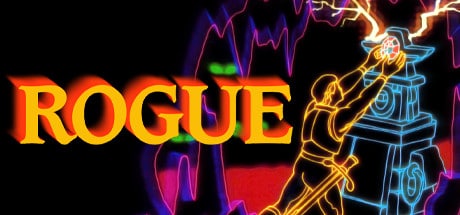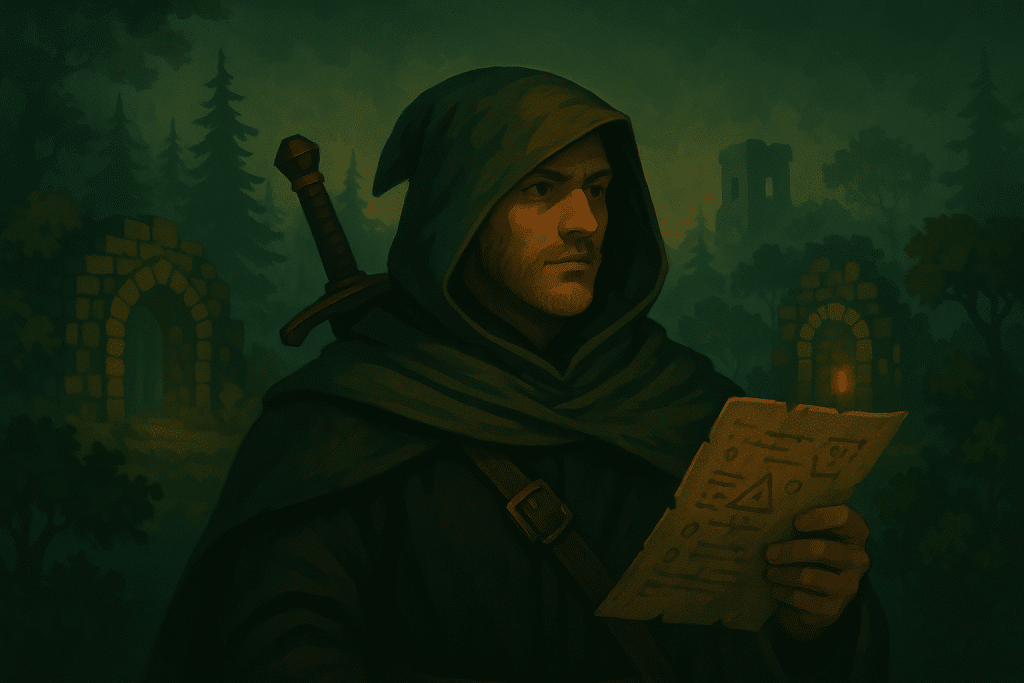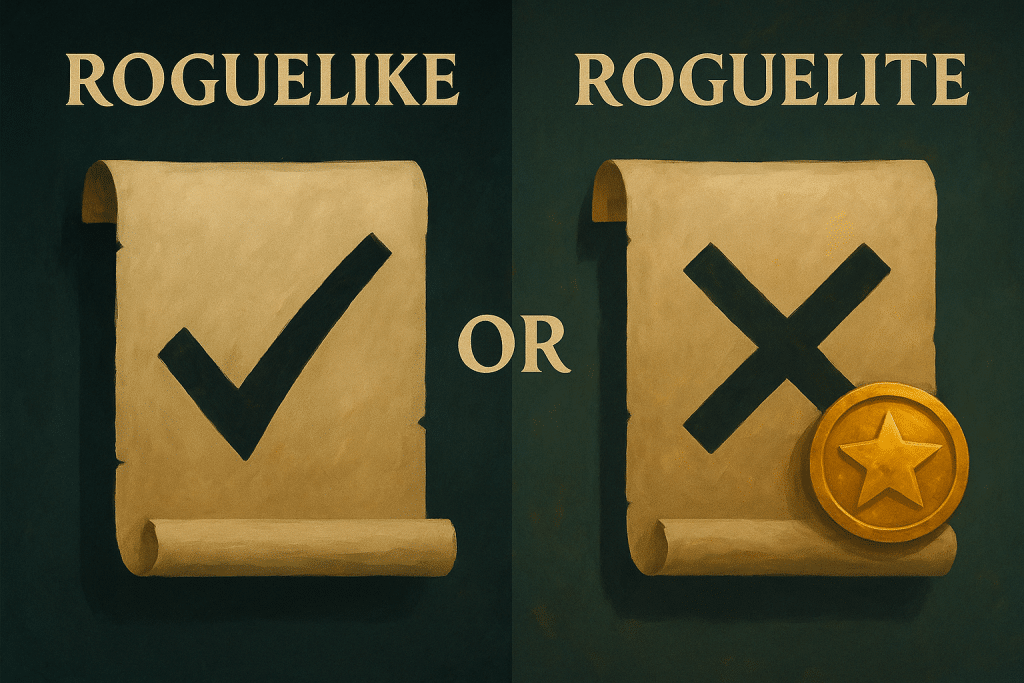When I discovered rogue games, it took me a minute to wrap my head around the concept of like vs. lite.
Now, in hindsight, I should have just played Rogue on day 1 to understand the origin story, but I didn’t.
I saw ‘like’ and ‘lite’ thrown around and wasn’t sure if it was roguelite or roguelike.
Admittedly, I just thought people were saying the same thing at times, but then I went down the rabbit hole.
During my original deep dive to define roguelike and the differences between roguelike and roguelite, information was scattered.
Don’t get me wrong, there were tons of YouTube videos, Reddit threads, and the like, but I wanted a central guide (hence why we are here).
So now I’m creating the easiest-to-understand guide on roguelike vs. roguelite for any who might follow in those footsteps.
TL;DR (Too Long; Didn’t Read)
- Roguelikes vs. Roguelites: Roguelikes are strict “start over from scratch” games, while roguelites let you carry some progress between runs.
- Roguelike traits: Permadeath, procedural generation, impactful RNG, no permanent upgrades and no game saves.
- Roguelite traits: Permadeath and procedural levels, but softened with persistent upgrades, unlocks, or story progression.
- Overlap: Every roguelike can be called a roguelite (since it shares the core DNA), but not every roguelite can be called a roguelike.
- Examples: Roguelike: ADOM, Caves of Qud, Dungeon Crawl Stone Soup. Roguelite: Hades, Dead Cells, Vampire Survivors, Brotato.
- Other genres: Bullet Hell = dodge everything (Enter the Gungeon). Bullet Heaven = you are the storm (Vampire Survivors, Brotato).
What Was The First Roguelike Game?
Subtly linked above is Rogue, the game that started it all.
To understand the roguelike genre, we need to start there.
Also known as Rogue: Exploring the Dungeons of Doom, this turn-based dungeon crawler welcomes players to a punishing playstyle with arms wide open (I’ll resist the urge to add a meme below).
What’s so punishing?
Permadeath and procedurally generated playthroughs.

What does that all mean?
Turn-based: Everything in the game is defined by “turns,” such as your character’s next move, attack, item usage, etc.
Dungeon Crawler: A style of game where players have to navigate a dungeon, fight off monsters, avoid traps, solve puzzles, and collect treasure.
Permadeath: You play, die, and restart from the beginning with zero offensive or defensive items and weapons you might have collected along the way.
Procedurally generated playthroughs: Monsters, maps, and treasures are randomized, and just because you achieved X at Y point of the game, it does not mean you will reencounter it.
Now, although Rouge wasn’t the first game to have these features, its popularity grew and soon became a reference to other games that carried similar mechanics.
What Are Roguelike Games?
Before we proceed, we must give credit where credit is due.
Thanks to the International Roguelike Development Conference in 2008, a group of developers helped define roguelike via the “Berlin Interpretation,” an outline of ‘how roguelike a game is.’
While it is essential to note its origin, the historical depths and nuances are not critical to our conversation. If you would like to learn more, there’s an entire Wikipedia page dedicated to the Berlin Interpretation.
So wait, what is a roguelike game?
At its core, a roguelike video game embodies:
- Complexity: Tons of mechanics, items, builds, and strategies.
- Restricted-Movement: You can expect grids, arenas, and dungeons.
- No Meta Progression: Each run is self-contained; no permanent unlocks.
- Permadeath: When you die, your run is over and you restart from scratch.
- Procedural Generation: Levels, items, and enemies are different each time.
- Skill-Based: Progress is almost always proportionate to skill level, not play time.
- Non-modal: All actions (such as combat and movement) happen in the same “mode.”
But as mentioned above, a game does not need to have all of these mechanics to be considered roguelike.
Also, a special shoutout to Synaptics in this Reddit post for providing a clear explanation of non-modal, which I used in this context.

Why is it Called Roguelike?
A game is called roguelike because it has some (but not all) of the core features of Rogue. Features can include, but are not limited to, permadeath, procedural generation, turn-based, no meta progression, etc.
However, a common pitfall of the term roguelike is that people hear it and have never heard of the game, Rogue. When really, it’s the combination of Rogue (the game) and ‘like.’
Said differently, “this game is like Rogue”.
Examples of Roguelike Games
I’ll keep this section pretty short, but I thought it might be helpful to list a few roguelike examples (in alphabetical order) and link to their Steam pages.
Now, before you come for me, I know this is not a complete list 🙂
- ADOM (Ancient Domains of Mystery)
- Caves of Qud
- Dungeon Crawl Stone Soup (DCSS)
- Death Must Die
- Path of Achra
- Shiren the Wanderer
- Tales of Maj’Eyal
Adding a few of the big names for quick reference.
What is a Roguelite?
A roguelite borrows elements from roguelikes like procedural generation and permadeath, to name a few, but softens the punishment by granting meta progression across runs.
For me, the roguelite meaning clicked when I realized that you can still make progress in the game after dying (AKA, you get to keep items, positions in-level, or powerups).
Some popular roguelites are below:
Roguelite examples
- Against the Storm
- Balatro
- Brotato
- Darkest Dungeon
- FTL: Faster Than Light
- Slay the Spire
- Spelunky 2
- Vampire Survivors

What is the Difference Between Roguelike and Roguelite?
To recamp, here’s a quick breakdown of roguelike vs. roguelite:
| Category | Roguelike | Roguelite |
|---|---|---|
| Definition | Strictly modeled after Rogue; includes permadeath, RNG, and skill based mechanics. | Inspired by roguelikes, but way more forgiving. Death resets the run, but you keep some progress. |
| Permadeath | No doubt, this is the most brutal style of gameplay. You die, you’re done. Time to start over. | Far less punishing. If you die, you get to keep weapons, skills, or perks for the next attempt. |
| Progression | There is none. If you die, you restart the playthrough fresh. | Players get persistent upgrades and meta-progression across runs. |
| Gameplay Style | Even the little wins feel massive. These are not idle games, expect to give it your all just to survive. Slow methodic play is encouraged. | Usually real-time. Faster, flashier, and more accessible. |
| Learning Curve | These games are hard. You only get better by playing more and learning the nuances of the game. | Easy to learn, hard to master. Players can get stronger over time, but skill is still a factor. |
| Replayability | Endless variety through procedural generation and player mastery. | Still has variety, but with the satisfaction of steady progression and unlocks. |
| Examples | ADOM, Caves of Qud, Dungeon Crawl Stone Soup, NetHack. | Hades, Dead Cells, Slay the Spire, Vampire Survivors. |
| Design Philosophy | “When you die, you start over.” | “Before you die, you might grow a little stronger for the next game.” |
So is it Roguelike or Roguelite?
It’s both, but not always.
Let me explain.
A roguelike can be called a roguelite because it still has permadeath and procedurally generated gameplay, which is the core.
But a roguelite cannot always be called a roguelike because it usually breaks one or more “strict” rules, like no meta-progression.
That said, some games straddle the line.
They keep most roguelike elements and sneak in one or two roguelite traits.
Let’s take two of my favorite games, for example:
Brotato: You have procedural waves, permadeath, and runs that force tough build choices, which are fundamental roguelike traits. However, it also gives permanent unlocks and character variety between runs, which are roguelite traits.
Side note: we have a pretty in-depth write up if you’re on the hunt for games similar to Brotato.
Vampire Survivors: Thanks to procedural enemy swarms and permadeath, every run is different, but the gold-based meta progression puts the game in roguelite territory.
So even though both games borrow from roguelikes, their persistent upgrade systems keep them firmly in the roguelite camp.
It’s very similar to how not every rectangle is a square, but every square is a rectangle.

What About Bullet Hell and Bullet Heaven Games?
I also wanted to touch on bullet hell and bullet heaven since these are often thrown into the mix with these games.
Bullet Hell games like Enter the Gungeon or Touhou are all about dodging insane patterns of projectiles. Bullet hell games often overlap with roguelites because they use permadeath and procedural runs, but the focus is on reflexes and dodging rather than grid-based tactics.
Bullet Heaven games like Vampire Survivors or Brotato flip the script (read our review of Brotato). Instead of weaving through enemy fire, you become the storm. Most of the time, your screen fills with enemies, and your character auto-attacks while you focus on movement and survival.
These genres borrow roguelite mechanics but aren’t roguelikes themselves.
Roguelike FAQ: Is [Game] a Roguelike?
Here are some frequently asked questions surrounding certain games and whether they are roguelike or roguelite.
Is Cult of the Lamb a Roguelike?
Cult of the Lamb is a Roguelite. The dungeon crawling has permadeath, but you return to your base where progression, upgrades, and followers carry over.
Is Balatro a Roguelike?
Balatro is often called a roguelike deck-builder. Each run is unique, permadeath is always present, and the combination creates wildly different outcomes. However, there is some progression in the cards that you unlock throughout your playthroughs.
Is Nightreign a Roguelike?
Nightreign is a standalone Elden Ring entry and isn’t positioned as a roguelike or roguelite.
Is Fear and Hunger a Roguelike?
Fear and Hunger is a survival horror that borrows from roguelikes. It is brutal, permadeath exists, and runs can end quickly, but it is not a traditional roguelike.
Is Blue Prince a Roguelike?
Blue Prince plays closer to a roguelike because it uses procedural mansion layouts, permadeath, and the house resets every day.
Is Noita a Roguelike?
Noita is a roguelite action game. Runs are procedural and death is permanent, but unlocks move it away from a strict roguelike.
Is Lethal Company a Roguelike?
Lethal Company is not a roguelike. It is a cooperative horror game with procedurally generated maps, but it doesn’t feature permadeath.
Is Risk of Rain 2 a Roguelike?
Risk of Rain 2 is a self proclaimed action roguelike, but does feature a lot of progression. You unlock new items and playable survivors.
Is Sifu a Roguelike?
Sifu is not a roguelike. It is an action brawler with aging mechanics rather than procedural levels or permadeath-driven design.
Is Death’s Door a Roguelike?
Death’s Door is not a roguelike. It is a souls-like game. This is a fixed-world action-adventure with handcrafted environments and story progression.
Is Pokémon Mystery Dungeon a Roguelike?
Pokémon Mystery Dungeon is a roguelike. It includes procedural dungeons, permadeath, grid-based movement, and turn-based actions.
Is R.E.P.O. a Roguelike?
R.E.P.O is not a roguelike. It is a cooperative horror game where you complete jobs to satisfy your creator, much like the Corporation in Lethal Company.
Is Inscryption a Roguelike?
Inscryption uses roguelike deckbuilding in parts of the game, but overall, it is more of a hybrid puzzle and horror experience.
Is Spelunky a Roguelike?
Spelunky is a roguelike platformer. Community docs explicitly note it isn’t “pure,” but it is the archetypal roguelike-platformer..
Is Darkest Dungeon a Roguelike?
Officially described as a roguelike RPG..
Is Risk of Rain a Roguelike?
The original Risk of Rain is a roguelite. Like its sequel, it features procedural levels and permadeath, as well as progression systems that carry over across playthroughs.
Is Nier: Automata a Roguelike?
Nier: Automata is not a roguelike. It is an action RPG with a fixed story and progression rather than procedural runs.
Is Witchfire a Roguelike?
Witchfire is a roguelite FPS. It has procedural runs, permadeath, and progression systems that extend beyond a single playthrough.
Is Vampire Survivors a Roguelike?
Vampire Survivors is a roguelite, often called a bullet heaven. Runs are procedural, and death ends the attempt, but permanent upgrades are unlocked with gold.
Is The Binding of Isaac a Roguelike?
The Binding of Isaac is commonly labeled a roguelike action-adventure, but it does have meta-unlock systems, which is why people debate it.
Is Dead Cells a Roguelike?
Dead Cells is a roguelite. Permadeath and procedural levels are present, but weapons and upgrades carry over across runs.
Is Diablo a Roguelike?
Diablo is not a roguelike. It is an action RPG. While it draws inspiration from dungeon-crawling roguelikes, it is defined by fixed progression.
Is Pacific Drive a Roguelike?
Pacific Drive is a survival roguelite. It features procedural runs, permadeath, and long-term progression between expeditions.
Is Side Order a Roguelike?
Splatoon 3: Side Order is a roguelite expansion. It uses randomized runs, upgrades, and progression mechanics, but it is not a traditional roguelike.
Is Deathloop a Roguelike?
Deathloop is not a roguelike. Its loop mechanic is tied to story and immersive sim design rather than roguelike systems.
Is Bastion a Roguelike?
Bastion is not a roguelike. It is a story-driven action RPG with handcrafted levels and no permadeath.
Wrapping Things Up
Roguelikes, not to be confused with roguelites, are a fun and challenging game that will leave you pissed and wanting more all in the same playthrough.
As mentioned, when I first started my journey, the -like and -lite overlap sent me spiraling.
I hope this guide clarifies things for others in a similar situation and makes everything less confusing.
Take care and talk soon.

